Clean Style Deadlift Technique
Having examined Bench Press Technique fairly recently, I wanted to cover another important (and usually improperly done) exercise and that is the clean style deadlift. And while deadlifts are certainly less likely to be seen at the average commercial gym, when they are seen it’s usually a biomechanical horror that makes your back hurt to watch.
And just as I was talking about a very specific style of bench press in the previous technique article, I want to make it clear that this piece is only detailing the clean style deadlift. I mention this in that, in recent years, other deadlift techniques have become somewhat more common. Rounded upper backs and more of a stiff-legged type of DL are being seen. This seems to be especially true in geared powerlifting and among super-heavyweight lifters. But those are very specific styles of deadlift for every specific purposes.
However, some very very big weights have been moved in a style at least similar to what I’m going to present. A clean style deadlift is the style used specifically by Olympic lifters and, while there are slight differences between that and a clean grip power style deadlift, they are fairly minor. The biggest difference is what happens into the second pull as the bar passes the knee, Olympic lifters are using the initial pull to set up for the explosion in the second pull, powerlifters are just trying to lock the bar out.
Like the generic raw power bench press, the clean style deadlift is what I’d teach the average lifter looking for strength or size gains, even more so if at some point they were going to learn power cleans. Clearly, this article doesn’t address sumo technique either.
Muscles Targeted
The clean style deadlift involves a tremendous amount of musculature and movements around the hips and knees (and even ankles a bit) and involves most muscles in the body. The lower body (quads, hams, glutes) are involved heavily but so is the upper body (lower back, upper back, lats) to stabilize the torso for the pull. If, for some weird reason, you had to pick a single exercise to hit the most muscles possible, the deadlift would be right up there on the list. Add an upper body pushing movement of some sort and you’d have a pretty damn good routine.
Technique: Introductory Comments
The DL generally starts from the floor although it’s not unheard of for lifters to start from the top (taking the bar out of a rack) and beginning the movement by lowering; quite in fact this tends to put many lifters in a better position for the next repetition than starting from the floor, it also tends to let people pull bigger weights since you can get an effect of pre-stretch on the initial lowering. Powerlifters, in general, don’t do this (since they have to pull from the floor in competition) although at least one elite deadlifter does a workout where he starts a heavier than normal weight from the top position.
The deadlift is different than many other movements (such as the squat or bench press) in that it starts from a dead stop position at the bottom. This prevents the lifter from relying on elastic energy, generated during the eccentric to start the bar. This is at least part of why many lifters find that their second repetition of a set of deadlifts is generally better than the first.
Some lifters get around this by dive bombing from a standing position or dipping their hips to get an explosive start; both of these are advanced techniques and I’m only mentioning them for completeness. You have to be very skilled to avoid shooting the hips (see below) with this method.
Perhaps more so than any other movement, the starting position of the DL is absolutely key to a safe and effective pull; it’s also where a lot of people screw it up. In the version I’m teaching, the following points are important.
Putting the Bar at an Appropriate Height
Before addressing proper deadlift technique, I want to make a seemingly obvious point. Although I shot these pictures of my lovely model without plates on the bar (to make it easier to see what was going on), I actually made sure that the bar was in the proper position in the start position.
And that position is where a 45 pound plate would place it off the floor. A mistake many beginners make is to start with smaller plates on the bar and then they wonder why they have problems.
What to do? There are several options including:
The following picture demonstrates this, showing where the bar would be with 45 pound plates on the bar.
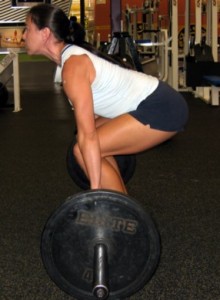 Proper Bar Height
Proper Bar Height
Proper Deadlift Technique
The torso/hip position can vary slightly depending on body length, longer legged lifters will typically have to start with their hips a bit higher than those with short legs to get into a proper position. The starting position shown from the side (left) appears below. Note that the lifter’s upper back is flat or slightly arched, she is also pulling her shoulder blades back to ‘set’ her upper back. She is also attempting to lift her chest slightly (to maintain a proper upper back position).
While there is some debate over proper head position, I find that teaching a neutral or slightly upward looking head position facilitates keeping the chest high and upper back flat and this is what I teach/advocate. Some great lifters can and have done a proper clean style deadlift with the head looking downwards slightly but it takes a great deal of practice to keep the chest high and not let the shoulders fall behind the hips when the pull is started.
 Clean Grip Deadlift Start
Clean Grip Deadlift Start
Starting with the hips either too high or too low (not shown) are both common problems. With the hips too high, the movement becomes like a stiff legged deadlift off the floor. With the hips too low, the glutes and hamstrings can’t contribute as well, the quads are forced to take over the work. Ideally an even contribution of quads, glutes and hamstrings should occur.
As the bar leaves the floor, the hips and shoulders should initially rise at the same time, keeping the torso angle the same. This occurs through extension of the knees and the bar should move slightly back and upwards as the knees move backwards (out of the way of the bar).
As the bar comes past the knee, the lifter starts to pull the bar back (leading with the shoulders and driving the hips through) sliding the bar up the thigh to lockout as the knees continue to straighten. The below sequence of pictures shows a conventional deadlift from start to finish.
 Start
Start
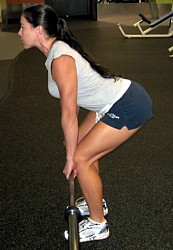 Below the Kne
Below the Kne
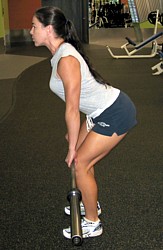 Above the Knee
Above the Knee
 Finish
Finish
Ok, so let’s look at a few of the problems that can occur. A very common problem is a rounded back in the bottom position. The low back often tucks (due to hamstring inflexibility) and/or the upper back rounds. I should note that some top powerlifters feel that rounding the upper back is a better way to deadlift. I suspect that a lot of this is a concession to deadlift suits (which tend to force lifters to round) although rounding will tend to put the bar in a more biomechanically advantageous position; it lets lifters sit into the lift more and get more leg drive. I’m not convinced it is the most healthy technique for the shoulder girdle.
However, as noted this is an article about clean style deadlifts and that means keeping the back flat and I’m going to address rounding as a technique flaw for this style of deadlift. A proper starting position (upper back flat or slightly arched) is show on the left with a rounded start shown on the right.
 Clean Grip Deadlift Start
Clean Grip Deadlift Start
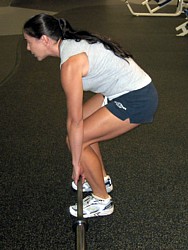 Back Rounded
Back Rounded
Another problem is letting the bar come out from the body. The bar should stay as close to the shins as possible (with many lifters dragging the bar up the shins and using talcum powder to minimize friction). Not only does allowing the bar to swing out drastically increase the stress on the low-back (in a bad way), it makes it extremely likely that you’ll miss the lift. A proper, keeping the bar in technique, is shown on the left; in the right picture the lifter has let the bar swing far out in front of them.
 Above the Knee
Above the Knee
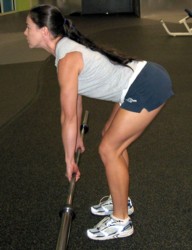 Bar Too Far in Front
Bar Too Far in Front
Two common problems can occur at lockout. The first is when the lifter fails to get the shoulders back at the end of the lift (or fails to keep them back during the lift). The second is when the lifter leans too far back, hyper-extending the low back. The proper finishing position is shown on the far left, rounded shoulders is in the middle, hyper-extension on the far right.
 Finish
Finish
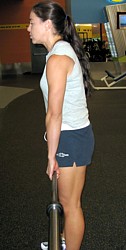 Shoulders Rounded
Shoulders Rounded
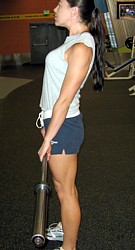 Hyperextension
Hyperextension
A final, and very common, problem is letting the hips raise more quickly than the shoulders (which I call ‘shooting the hips’; note that some lifters use shooting the hips to describe what happens at the end of the lift when the hips are driven through to finish the lockout).
This frequently happens if the lifter jerks at the bar or doesn’t think about driving the shoulders up as the bar comes off the floor. Weak glutes or quads can also contribute to this as the body tries to move the hamstrings into a better position biomechanically to stiff-leg the weight up. Finally, some lifters get so focused on pushing with the legs that they essentially forget to pull their shoulders up and back during the lift. So their butt shoots up into the air and they ‘lose their shoulders’ behind the pull.
As noted above, the hips and shoulders should rise at the same time which means that the torso angle should stay the same until the bar passes the knee. The left-most picture is a correct starting position. In the middle, the lifter has properly started the lift with the hips and shoulder rising at the same speed. Note that the bar is higher on the shins but the angle of the back to the floor has not changed. In the far right picture, that bar is in the same starting position; the hips have raised without moving the bar off the floor. Note how the angle of the back to the floor has decreased, the back is flatter because the hips have risen faster than the shoulders.
 Clean Grip Deadlift Start
Clean Grip Deadlift Start
 Below the Knee
Below the Knee
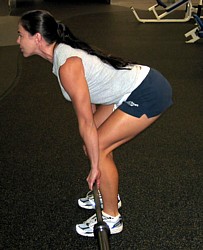 Shooting the Hips
Shooting the Hips
The descent of the deadlift is a matter of some debate. Technically it should be performed in reverse of what happens on the way up. The torso leans forwards as the knees bend slightly, sliding the bar down the thighs until it passes the knees at which point the bar is squatted down with knee flexion. As noted above, the second rep of a deadlift often looks much better than the first and part of it is that the hips tend to end up in a more natural position after the first descent.
The big debate is over the speed at which the descent is done. Many deadlifters feel that lowering heavy weights is dangerous and will essentially drop the bar, resetting before every rep. Others prefer to control the bar down fairly quickly, still needing to reset. Others will use a relatively slow eccentric so that they end up in the proper position at the bottom to start the next repetition. The latter is probably better for mass gains due to the importance of eccentric contractions for growth.
Another argument about deadlifts has to do with reps per set and how those reps are performed in terms of breaks between repetitions. Many powerlifters argue that since the deadlift is done for a single without the benefit of the stretch shorten cycle, it should be trained that way: single reps from a dead stop. From a powerlifting performance standpoint, they may not be incorrect.
A similar argument holds that it’s dangerous to do repetitions in the deadlift since technique will degrade with repetitions (low-back fatigue is usually cited). Maybe. Many lifters have done high rep sets (5-8 or even higher) in good form so it can be done.
Another issue is what to do between reps. The three basic options are to
Each has their pros and cons depending on what the lifter’s goal is. I’d probably say that option 1 is best for those looking to maximize strength as each rep starts from a dead stop, it’s also valuable for powerlifters who pull clean style as each rep is essentially a perfect single. I think option 2 is probably best for size gains since more tension is kept on the muscles without resting. Option 3 is best left to very advanced lifters since the act of bouncing the plates will throw most people far far out of proper lifting position and they are more likely to get hurt than to get anything of benefit out of the technique.
Finally, a little bit About Grip and Straps
Finally, I want to talk about grip a bit (I’ll cover this in more detail in a future site update). Probably the most common grip used for the deadlift is the mixed grip with one hand going over the bar (pronated) and the other under (supinated). This tends to be stronger than either an overhand grip or the hook grip. However, it also puts a slight torque across the spine and some injuries (including biceps tears) have occasionally occurred. All you have to do is bend the undergrip hand a little bit and you can tear a biceps with any heavy weight.
Another option is to use a double overhand grip which is exactly what it sounds like, both hands grip over the bar; the thumb closes over the fingers in the double overhand grip. This is generally weaker than the mixed grip but avoids torque across the spine of imbalances.
A third option is the hook grip which is what Olympic lifters and some powerlifters use. It is a double overhand grip but the thumbs are pinned under the first two or three fingers. As an Olympic lifter will tell you, the hook grip is stronger than a regular overhand grip. But it is painful when you first do it.
So which is better? As above, mixed grip is probably stronger of the three although you can build a damn strong hook grip if you start early enough. Regular overgrip is the weakest although it can be used if you use lifting straps. If you use the mixed grip, I recommend switching which hand is over and which is under from set to set (it will feel weird at first) to avoid a chronic imbalance through the spine.
What about lifting straps? Hardhead purists will tell you to never use straps to deadlift. And, for a powerlifter who needs to build their grip strength, they may not be incorrect. However, for general training purposes, straps can be beneficial; a bodybuilder or other non-powerlifting athlete shouldn’t let grip limitations hold back the training stimulus to their other muscles.
What I recommend is to try and avoid straps during a workout as long as possible. When you reach the point that grip becomes limiting, strap up. That way, you build your grip and you get the full workout done. This goes for all back work. I’ll cover the proper use of straps in a future article.
Having examined Bench Press Technique fairly recently, I wanted to cover another important (and usually improperly done) exercise and that is the clean style deadlift. And while deadlifts are certainly less likely to be seen at the average commercial gym, when they are seen it’s usually a biomechanical horror that makes your back hurt to watch.
And just as I was talking about a very specific style of bench press in the previous technique article, I want to make it clear that this piece is only detailing the clean style deadlift. I mention this in that, in recent years, other deadlift techniques have become somewhat more common. Rounded upper backs and more of a stiff-legged type of DL are being seen. This seems to be especially true in geared powerlifting and among super-heavyweight lifters. But those are very specific styles of deadlift for every specific purposes.
However, some very very big weights have been moved in a style at least similar to what I’m going to present. A clean style deadlift is the style used specifically by Olympic lifters and, while there are slight differences between that and a clean grip power style deadlift, they are fairly minor. The biggest difference is what happens into the second pull as the bar passes the knee, Olympic lifters are using the initial pull to set up for the explosion in the second pull, powerlifters are just trying to lock the bar out.
Like the generic raw power bench press, the clean style deadlift is what I’d teach the average lifter looking for strength or size gains, even more so if at some point they were going to learn power cleans. Clearly, this article doesn’t address sumo technique either.
Muscles Targeted
The clean style deadlift involves a tremendous amount of musculature and movements around the hips and knees (and even ankles a bit) and involves most muscles in the body. The lower body (quads, hams, glutes) are involved heavily but so is the upper body (lower back, upper back, lats) to stabilize the torso for the pull. If, for some weird reason, you had to pick a single exercise to hit the most muscles possible, the deadlift would be right up there on the list. Add an upper body pushing movement of some sort and you’d have a pretty damn good routine.
Technique: Introductory Comments
The DL generally starts from the floor although it’s not unheard of for lifters to start from the top (taking the bar out of a rack) and beginning the movement by lowering; quite in fact this tends to put many lifters in a better position for the next repetition than starting from the floor, it also tends to let people pull bigger weights since you can get an effect of pre-stretch on the initial lowering. Powerlifters, in general, don’t do this (since they have to pull from the floor in competition) although at least one elite deadlifter does a workout where he starts a heavier than normal weight from the top position.
The deadlift is different than many other movements (such as the squat or bench press) in that it starts from a dead stop position at the bottom. This prevents the lifter from relying on elastic energy, generated during the eccentric to start the bar. This is at least part of why many lifters find that their second repetition of a set of deadlifts is generally better than the first.
Some lifters get around this by dive bombing from a standing position or dipping their hips to get an explosive start; both of these are advanced techniques and I’m only mentioning them for completeness. You have to be very skilled to avoid shooting the hips (see below) with this method.
Perhaps more so than any other movement, the starting position of the DL is absolutely key to a safe and effective pull; it’s also where a lot of people screw it up. In the version I’m teaching, the following points are important.
- Shoulders are directly over or slightly in front of the bar, the grip should be set with the hands slightly outside of the legs so that the arms are as vertical as possible.
- Torso is rigid with the upper and lower back set tight and the upper back flat. It is possible to get too much arch in the back for very flexible trainees, but this isn’t common. Most have the reverse problem, rounding out in their upper or lower back, usually due to poor flexibility.
- Bar is over the mid foot.
- Knees are in front of the bar.
- Feet are about hip width with toes turned out slightly, the weight should be felt across the whole foot or slightly on the heels. It should not be felt on the toes.
Putting the Bar at an Appropriate Height
Before addressing proper deadlift technique, I want to make a seemingly obvious point. Although I shot these pictures of my lovely model without plates on the bar (to make it easier to see what was going on), I actually made sure that the bar was in the proper position in the start position.
And that position is where a 45 pound plate would place it off the floor. A mistake many beginners make is to start with smaller plates on the bar and then they wonder why they have problems.
What to do? There are several options including:
- Training plates: Many companies make light plates (5-10 lbs) that are the same size as standard Olympic plates. This puts the bar in the right position to start the deadlift but with lighter weight. Gyms with Olympic bumpers (which range from 5-25kg) can also be used here. Finally, it is possible to make training plates out of wood, simply get a circle cut to the proper diameter with a hole in the middle big enough to put the bar in. They break easily but are cheaper than training plates.
- Set the bar in a power-rack at the right height on the pins: You can generally set the safety pins in a power rack to mimic the proper bar height (again, where a 45 pound plate would put the bar).
- Use blocks or aerobic steps: While my least preferred choice (since they tend to move a lot), you can use aerobic steps or blocks to set the bar at the proper starting height for a proper pull.
The following picture demonstrates this, showing where the bar would be with 45 pound plates on the bar.
 Proper Bar Height
Proper Bar HeightProper Deadlift Technique
The torso/hip position can vary slightly depending on body length, longer legged lifters will typically have to start with their hips a bit higher than those with short legs to get into a proper position. The starting position shown from the side (left) appears below. Note that the lifter’s upper back is flat or slightly arched, she is also pulling her shoulder blades back to ‘set’ her upper back. She is also attempting to lift her chest slightly (to maintain a proper upper back position).
While there is some debate over proper head position, I find that teaching a neutral or slightly upward looking head position facilitates keeping the chest high and upper back flat and this is what I teach/advocate. Some great lifters can and have done a proper clean style deadlift with the head looking downwards slightly but it takes a great deal of practice to keep the chest high and not let the shoulders fall behind the hips when the pull is started.
 Clean Grip Deadlift Start
Clean Grip Deadlift StartStarting with the hips either too high or too low (not shown) are both common problems. With the hips too high, the movement becomes like a stiff legged deadlift off the floor. With the hips too low, the glutes and hamstrings can’t contribute as well, the quads are forced to take over the work. Ideally an even contribution of quads, glutes and hamstrings should occur.
As the bar leaves the floor, the hips and shoulders should initially rise at the same time, keeping the torso angle the same. This occurs through extension of the knees and the bar should move slightly back and upwards as the knees move backwards (out of the way of the bar).
As the bar comes past the knee, the lifter starts to pull the bar back (leading with the shoulders and driving the hips through) sliding the bar up the thigh to lockout as the knees continue to straighten. The below sequence of pictures shows a conventional deadlift from start to finish.
 Start
Start Below the Kne
Below the Kne Above the Knee
Above the Knee Finish
FinishOk, so let’s look at a few of the problems that can occur. A very common problem is a rounded back in the bottom position. The low back often tucks (due to hamstring inflexibility) and/or the upper back rounds. I should note that some top powerlifters feel that rounding the upper back is a better way to deadlift. I suspect that a lot of this is a concession to deadlift suits (which tend to force lifters to round) although rounding will tend to put the bar in a more biomechanically advantageous position; it lets lifters sit into the lift more and get more leg drive. I’m not convinced it is the most healthy technique for the shoulder girdle.
However, as noted this is an article about clean style deadlifts and that means keeping the back flat and I’m going to address rounding as a technique flaw for this style of deadlift. A proper starting position (upper back flat or slightly arched) is show on the left with a rounded start shown on the right.
 Clean Grip Deadlift Start
Clean Grip Deadlift Start Back Rounded
Back RoundedAnother problem is letting the bar come out from the body. The bar should stay as close to the shins as possible (with many lifters dragging the bar up the shins and using talcum powder to minimize friction). Not only does allowing the bar to swing out drastically increase the stress on the low-back (in a bad way), it makes it extremely likely that you’ll miss the lift. A proper, keeping the bar in technique, is shown on the left; in the right picture the lifter has let the bar swing far out in front of them.
 Above the Knee
Above the Knee Bar Too Far in Front
Bar Too Far in FrontTwo common problems can occur at lockout. The first is when the lifter fails to get the shoulders back at the end of the lift (or fails to keep them back during the lift). The second is when the lifter leans too far back, hyper-extending the low back. The proper finishing position is shown on the far left, rounded shoulders is in the middle, hyper-extension on the far right.
 Finish
Finish Shoulders Rounded
Shoulders Rounded Hyperextension
HyperextensionA final, and very common, problem is letting the hips raise more quickly than the shoulders (which I call ‘shooting the hips’; note that some lifters use shooting the hips to describe what happens at the end of the lift when the hips are driven through to finish the lockout).
This frequently happens if the lifter jerks at the bar or doesn’t think about driving the shoulders up as the bar comes off the floor. Weak glutes or quads can also contribute to this as the body tries to move the hamstrings into a better position biomechanically to stiff-leg the weight up. Finally, some lifters get so focused on pushing with the legs that they essentially forget to pull their shoulders up and back during the lift. So their butt shoots up into the air and they ‘lose their shoulders’ behind the pull.
As noted above, the hips and shoulders should rise at the same time which means that the torso angle should stay the same until the bar passes the knee. The left-most picture is a correct starting position. In the middle, the lifter has properly started the lift with the hips and shoulder rising at the same speed. Note that the bar is higher on the shins but the angle of the back to the floor has not changed. In the far right picture, that bar is in the same starting position; the hips have raised without moving the bar off the floor. Note how the angle of the back to the floor has decreased, the back is flatter because the hips have risen faster than the shoulders.
 Clean Grip Deadlift Start
Clean Grip Deadlift Start Below the Knee
Below the Knee Shooting the Hips
Shooting the HipsThe descent of the deadlift is a matter of some debate. Technically it should be performed in reverse of what happens on the way up. The torso leans forwards as the knees bend slightly, sliding the bar down the thighs until it passes the knees at which point the bar is squatted down with knee flexion. As noted above, the second rep of a deadlift often looks much better than the first and part of it is that the hips tend to end up in a more natural position after the first descent.
The big debate is over the speed at which the descent is done. Many deadlifters feel that lowering heavy weights is dangerous and will essentially drop the bar, resetting before every rep. Others prefer to control the bar down fairly quickly, still needing to reset. Others will use a relatively slow eccentric so that they end up in the proper position at the bottom to start the next repetition. The latter is probably better for mass gains due to the importance of eccentric contractions for growth.
Another argument about deadlifts has to do with reps per set and how those reps are performed in terms of breaks between repetitions. Many powerlifters argue that since the deadlift is done for a single without the benefit of the stretch shorten cycle, it should be trained that way: single reps from a dead stop. From a powerlifting performance standpoint, they may not be incorrect.
A similar argument holds that it’s dangerous to do repetitions in the deadlift since technique will degrade with repetitions (low-back fatigue is usually cited). Maybe. Many lifters have done high rep sets (5-8 or even higher) in good form so it can be done.
Another issue is what to do between reps. The three basic options are to
- Rest completely between reps, reset to a proper lifting position and pull. This treats the set like a series of singles.
- Lower the bar into a proper deadlift position, pause briefly on the floor (without losing body position) before starting the next pull. This allows you to get some benefit of the stretch-shorten cycle and is generally a little bit easier than method 1.
- Use a touch and go or even small bounce off the floor. For most people, I don’t recommend this; most lifters won’t maintain a good back position.
Each has their pros and cons depending on what the lifter’s goal is. I’d probably say that option 1 is best for those looking to maximize strength as each rep starts from a dead stop, it’s also valuable for powerlifters who pull clean style as each rep is essentially a perfect single. I think option 2 is probably best for size gains since more tension is kept on the muscles without resting. Option 3 is best left to very advanced lifters since the act of bouncing the plates will throw most people far far out of proper lifting position and they are more likely to get hurt than to get anything of benefit out of the technique.
Finally, a little bit About Grip and Straps
Finally, I want to talk about grip a bit (I’ll cover this in more detail in a future site update). Probably the most common grip used for the deadlift is the mixed grip with one hand going over the bar (pronated) and the other under (supinated). This tends to be stronger than either an overhand grip or the hook grip. However, it also puts a slight torque across the spine and some injuries (including biceps tears) have occasionally occurred. All you have to do is bend the undergrip hand a little bit and you can tear a biceps with any heavy weight.
Another option is to use a double overhand grip which is exactly what it sounds like, both hands grip over the bar; the thumb closes over the fingers in the double overhand grip. This is generally weaker than the mixed grip but avoids torque across the spine of imbalances.
A third option is the hook grip which is what Olympic lifters and some powerlifters use. It is a double overhand grip but the thumbs are pinned under the first two or three fingers. As an Olympic lifter will tell you, the hook grip is stronger than a regular overhand grip. But it is painful when you first do it.
So which is better? As above, mixed grip is probably stronger of the three although you can build a damn strong hook grip if you start early enough. Regular overgrip is the weakest although it can be used if you use lifting straps. If you use the mixed grip, I recommend switching which hand is over and which is under from set to set (it will feel weird at first) to avoid a chronic imbalance through the spine.
What about lifting straps? Hardhead purists will tell you to never use straps to deadlift. And, for a powerlifter who needs to build their grip strength, they may not be incorrect. However, for general training purposes, straps can be beneficial; a bodybuilder or other non-powerlifting athlete shouldn’t let grip limitations hold back the training stimulus to their other muscles.
What I recommend is to try and avoid straps during a workout as long as possible. When you reach the point that grip becomes limiting, strap up. That way, you build your grip and you get the full workout done. This goes for all back work. I’ll cover the proper use of straps in a future article.


Comment